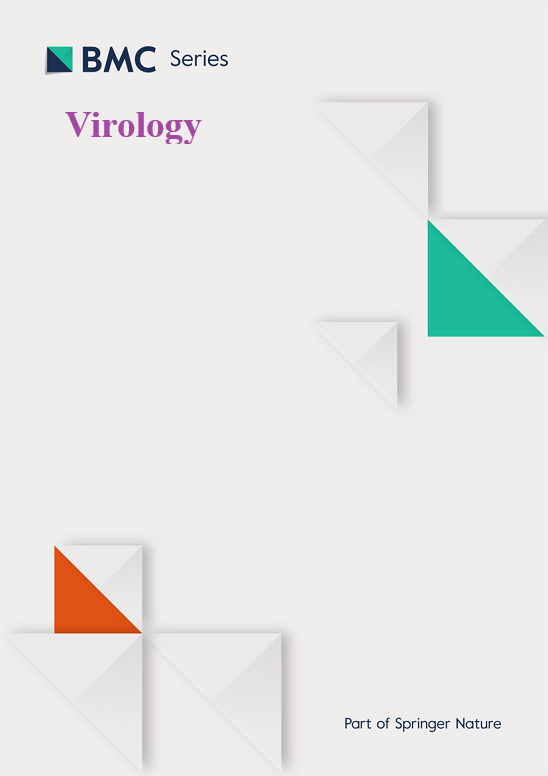Domestic cat hepadnavirus is detected infrequently in feline blood and liver samples submitted for diagnostic testing in Texas, USA
IF 2.8
3区 医学
Q3 VIROLOGY
引用次数: 0
Abstract
Domestic cat hepadnavirus (DCH), a novel hepatitis B-like virus, has been detected in cats in several regions but data are fragmented. Investigation of DCH is driven by the societal role of cats as human companions, disease risk to sympatric endangered felids, as well as HBV medicine. This study investigated the molecular epidemiology and sequence diversity of DCH in diagnostic blood or non-paired liver samples submitted in Texas. Patient age, sex, breed, neuter status, and retrovirus serology results were recorded for risk factor analyses. Using qPCR, DCH DNA was amplified from 3/400 blood samples (0.8 % (95 % CI: 0.3–2.2 %) with virus loads of 4.06 × 106, 2.33 × 108, and 27.1 × 109 copies/μL of blood. Feline immunodeficiency virus and feline leukemia virus seroprevalence was 4.3 % (95 % CI: 2.5–7.1 %) and 7.5 % (95 % CI: 5.0–10.8 %), respectively. A low DCH detection rate precluded risk factor analysis. Among liver samples, DCH DNA was amplified by PCR from 4/303 (1.3 % (95 % CI: 0.4–3.4 %), one of which also tested positive by in situ hybridization. Phylogenetic analyses of 3 DCH genomes obtained in this study showed high homology to viruses in Genotype A with no evidence of geographic clustering. This study, only the second in the USA, contributes to data on the worldwide prevalence of DCH viremia and, in the context of accumulating data on this potential feline pathogen, supports that the prevalence of DCH viremia, may vary geographically, as described for hepatitis-B virus and woodchuck hepatitis virus.
在美国德克萨斯州,家猫肝炎病毒很少在提交诊断检测的猫血液和肝脏样本中检测到
家猫肝炎病毒(DCH)是一种新型乙型肝炎样病毒,已在一些地区的猫中检测到,但数据不完整。猫作为人类伴侣的社会角色、同域濒危猫科动物的疾病风险以及HBV药物推动了DCH的调查。本研究调查了德克萨斯州提交的诊断血液或非配对肝脏样本中DCH的分子流行病学和序列多样性。记录患者的年龄、性别、品种、中性状态和逆转录病毒血清学结果,用于危险因素分析。采用qPCR技术,从3/400份血样中扩增出DCH DNA (0.8% (95% CI: 0.3 ~ 2.2%),病毒载量分别为4.06 × 106、2.33 × 108和27.1 × 109拷贝/μL。猫免疫缺陷病毒和猫白血病病毒的血清阳性率分别为4.3% (95% CI: 2.5 - 7.1%)和7.5% (95% CI: 5.0 - 10.8%)。低DCH检出率排除了危险因素分析。在肝脏样本中,PCR扩增出4/303(1.3%)的DCH DNA (95% CI: 0.4 - 3.4%),其中1个原位杂交检测呈阳性。本研究获得的3个DCH基因组的系统发育分析显示与基因型A病毒高度同源,没有地理聚类的证据。这项研究是美国的第二项研究,它为DCH病毒血症的全球流行提供了数据,并且在积累有关这种潜在猫科病原体的数据的背景下,支持DCH病毒血症的流行可能在地理上有所不同,正如乙型肝炎病毒和土拨鼠肝炎病毒所描述的那样。
本文章由计算机程序翻译,如有差异,请以英文原文为准。
求助全文
约1分钟内获得全文
求助全文
来源期刊

Virology
医学-病毒学
CiteScore
6.00
自引率
0.00%
发文量
157
审稿时长
50 days
期刊介绍:
Launched in 1955, Virology is a broad and inclusive journal that welcomes submissions on all aspects of virology including plant, animal, microbial and human viruses. The journal publishes basic research as well as pre-clinical and clinical studies of vaccines, anti-viral drugs and their development, anti-viral therapies, and computational studies of virus infections. Any submission that is of broad interest to the community of virologists/vaccinologists and reporting scientifically accurate and valuable research will be considered for publication, including negative findings and multidisciplinary work.Virology is open to reviews, research manuscripts, short communication, registered reports as well as follow-up manuscripts.
 求助内容:
求助内容: 应助结果提醒方式:
应助结果提醒方式:


